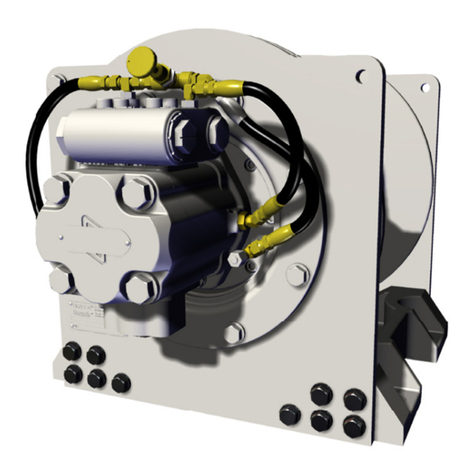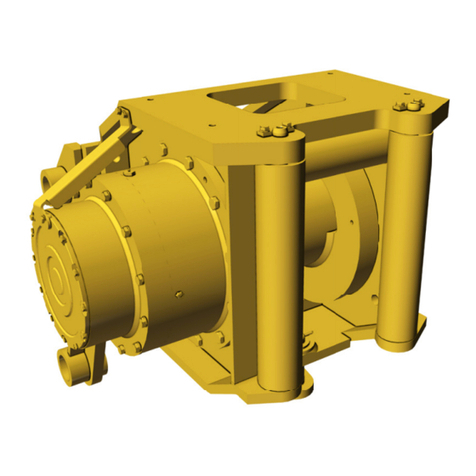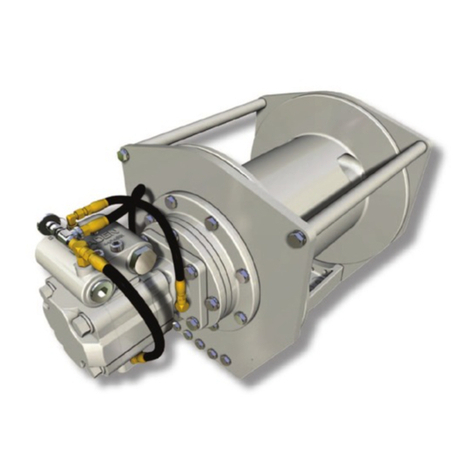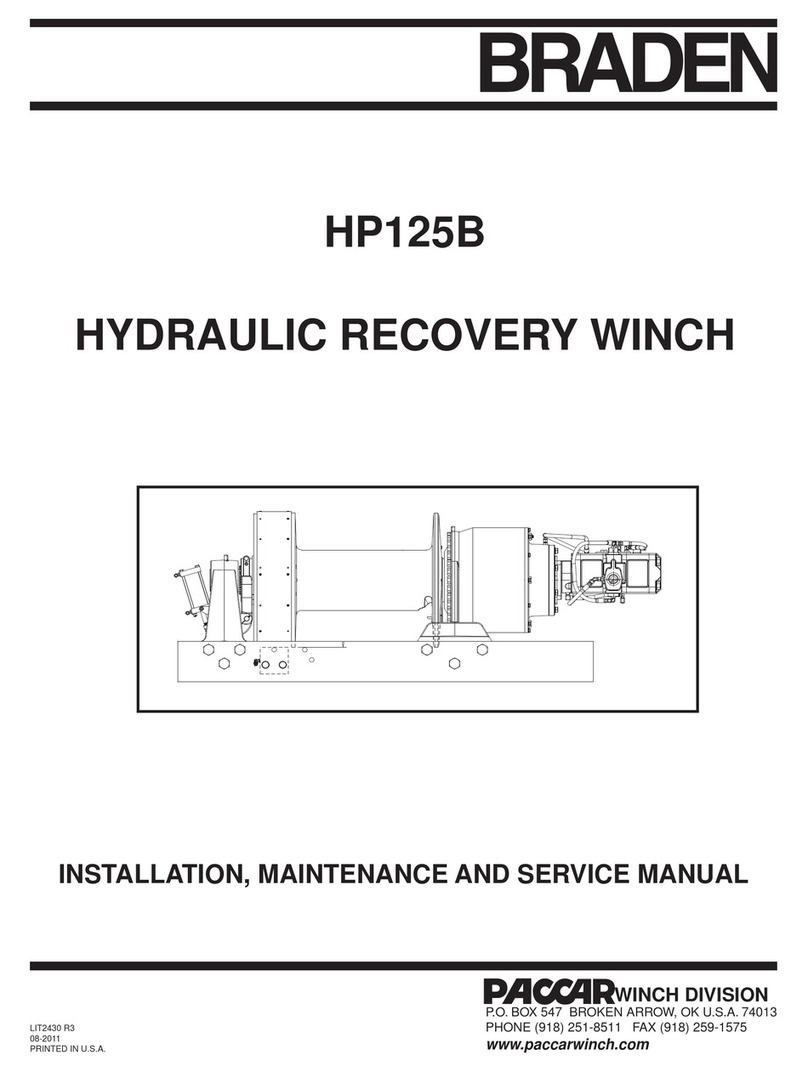Paccar CARCO 50B User manual

CARCO<
MODELS 50B & 70A
WITH ELECTRONIC CONTROL
SERVICE
MANUAL
LIT2055 R4
5/2010
Printed in U.S.A.
PACR WINCH DIVISION
P.O. BOX 547 BROKEN ARROW, OK U.S.A.74013
PHONE (918) 251-8511 FAX (918) 259-1575
www.paccarwinch.com
2010 PACCAR Winch Division
All rights reserved.


1
FOREWORD
Please read and understand this entire manual BEFORE operating or performing service on your CARCO winch.
Retain this publication for future reference.
This manual contains instructions for the service and repair of CARCO Models 50B & 70A power shift winches with
electronic controls.
Some illustrations in this manual may show details or attachments that may be different from your winch. Also, some
components may have been removed for clarity.
Continuing product improvements may cause changes in your winch, which are not included in this manual. Whenever
a questions arises regarding your CARCO winch or this publication, please contact the CARCO Service Department
at 1-918-251-8511, Monday - Friday, 0800 hrs - 1630 hrs CST, or by fax at 1-918-259-1575, or by e-mail at
winch.service@paccar.com. Provide the complete winch MODEL NUMBER and SERIAL NUMBER when making
inquiries. Refer to MODEL DESCRIPTION section for location of model and serial number.
This complete service manual is available for viewing and/or downloading as a .PDF file on our internet
website - http://www.paccarwinch.com/literaturelist.asp
TABLE OF CONTENTS
GENERAL SAFETY RECOMMENDATIONS . . . . . . . . . . . . . . . . . . . . . . . . . . . . . . . . . . . .2
MODEL DESCRIPTION . . . . . . . . . . . . . . . . . . . . . . . . . . . . . . . . . . . . . . . . . . . . . . . . . . . .3
PREVENTIVE MAINTENANCE & SPECIFICATIONS . . . . . . . . . . . . . . . . . . . . . . . . . . . . .4
CONTROL SYSTEM OPERATION & TROUBLE SHOOTING . . . . . . . . . . . . . . . . . . . . . .9
WINCH REMOVAL & INSTALLATION . . . . . . . . . . . . . . . . . . . . . . . . . . . . . . . . . . . . . . . .27
WIRE ROPE INSTALLATION & WELDING SPECIFICATIONS . . . . . . . . . . . . . . . . . . . . .28
BEVEL PINION & HYDRAULIC PUMP SERVICE . . . . . . . . . . . . . . . . . . . . . . . . . . . . . . .29
CLUTCH SHAFT SERVICE . . . . . . . . . . . . . . . . . . . . . . . . . . . . . . . . . . . . . . . . . . . . . . . .33
CLUTCH ASSEMBLY SERVICE . . . . . . . . . . . . . . . . . . . . . . . . . . . . . . . . . . . . . . . . . . . .40
BRAKE ASSEMBLY SERVICE . . . . . . . . . . . . . . . . . . . . . . . . . . . . . . . . . . . . . . . . . . . . . .43
IDLER SHAFT GROUP . . . . . . . . . . . . . . . . . . . . . . . . . . . . . . . . . . . . . . . . . . . . . . . . . . .46
FOURTH SHAFT GROUP . . . . . . . . . . . . . . . . . . . . . . . . . . . . . . . . . . . . . . . . . . . . . . . . .50
CABLE DRUM GROUP . . . . . . . . . . . . . . . . . . . . . . . . . . . . . . . . . . . . . . . . . . . . . . . . . . .52
CONTROL VALVE SERVICE . . . . . . . . . . . . . . . . . . . . . . . . . . . . . . . . . . . . . . . . . . . . . . .55
ACCUMULATOR SERVICE . . . . . . . . . . . . . . . . . . . . . . . . . . . . . . . . . . . . . . . . . . . . . . . .58
WARNING - This emblem is used to warn against haz-
ards and unsafe practices that COULD result in severe
personal injury or death if proper procedures are not
followed.
CAUTION - This emblem is used to warn against
potential or unsafe practices that COULD result in per-
sonal injury and product or property damage if proper
procedures are not followed.
i
CAUTION
Safety and informational callouts used in this manual include:
This emblem is used to indicate an informational note or service tip.

2
1. Read all warning tag information and become familiar
with all controls BEFORE operating the winch.
2. Never attempt to clean, oil or perform any mainte-
nance on the winch with the tractor engine running,
unless specifically instructed to do so in this manual.
3. Before starting the tractor engine, be certain all con-
trols move freely and are placed in the "Brake On"
(neutral) position.
4. Never operate the winch controls unless you are
properly seated at the operator's station on the trac-
tor and you are sure all personnel are clear of the
work area.
5. Never attempt to handle winch cable when the hook
end is not free. Keep all parts of body and clothing
clear of winch drum, cable rollers and entry area of
fairleads and arches.
6. Ground personnel should stay in clear view of the
tractor operator and clear of the winch drum. Do not
allow ground personnel near a winch line under ten-
sion. A safe distance of 1 ½ times the working length
of the cable should be maintained. Never allow any-
one to stand under a suspended load.
7. Avoid sudden "shock" loads or attempting to "jerk" a
load free. This type of operation may cause heavy
loads in excess of the rated winch capacity, which
may result in the failure of the cable and/or winch.
8. Use only GENUINE CARCO parts. Do not use parts
from other winch manufacturers on your CARCO
winch. Do not use CARCO parts on winches from
other manufacturers.
9. Use the correct size ferrule for the cable and pocket
in the winch drum. Never use knots to secure or
attach cable to the winch drum, or the hook to the
cable. The cable anchor or ferrule pocket in the cable
drum is designed to provide a self release in the
event a back-sliding load must be released from the
tractor in an emergency situation. The cable anchor
or ferrule alone will NOT support the rated capacity of
the winch. Therefore, a minimum of five (5) complete
wraps must be maintained on the winch drum.
NOTE: We suggest painting the last five wraps of
cable bright red to serve as a visual warning.
RECOMMENDED OPERATING PRACTICES
1. Leather gloves should be used when handling winch
cable.
2. Operate the winch to match line speeds to job condi-
tions.
3. Assure that personnel who are responsible for hand
signals are clearly visible and that the signals to be
used are thoroughly understood by everyone.
4. Inspect winch cable, rigging, winch and tractor at the
beginning of each work shift. Defects should be cor-
rected immediately.
5. Position the tractor for the straightest line of pull to
reduce the wear on the winch cable and ensure even
spooling.
6. When winding winch cable on the winch drum, never
attempt to maintain tension by allowing the winch
cable to slip through the hands. Always use the
"hand-over-hand" technique, being careful to keep
hands and clothing away from winch drum and fair-
lead rollers.
7. Be sure of tractor ground stability before winching in
a load.
8. Store unused chokers, slings and rigging in a neat
and orderly fashion to prevent damage to equipment
or injury to personnel.
9. Do not operate the winch under loads that exceed the
maximum rated bare drum line pull. If excessive
loads are encountered, use a multi-part line and
sheave blocks. Any attempt to exceed the capacity of
one winch (such as coupling 2 or more tractors
together) is extremely hazardous.
10. The factory approved adaptions for CARCO winches
are designed and intended for use on specific models
of crawler tractors. Changing winches between trac-
tors is not possible in some cases because of differ-
GENERAL SAFETY RECOMMENDATIONS
Safety for operators and ground personnel is of prime concern.Always take the necessary precautions to ensure safe-
ty to others as well as yourself. To ensure safety, the tractor and winch must be operated with care and concern by the
operator for the equipment, and a thorough knowledge of the machine's handling and performance capabilities. The
following recommendations are offered only as a guide for the operator. Local rules and regulations will also apply.
Failure to obey the following safety recommendations
may result in property damage, injury or death.
i

3
ences in tractor models. Some changes cannot be
approved by CARCO because of safety limitations.
Call a CARCO dealer or the CARCO factory prior to
attempting winch modifications or before mounting on
a different tractor.
11. CARCO power shift winches are equipped with
hydraulic accumulators. Discharge the accumulator
stored oil supply before removing any hydraulic lines
or fittings or servicing winch. Personal injury may
result from the sudden release of oil pressure. To dis-
charge the accumulator, stop the engine, turn the key
switch “on” then slowly cycle the Power Shift control
handle into full Reel-In then Reel-Out positions a min-
imum of five (5) times.
12. On machines having hydraulically, mechanically
and/or cable controlled equipment, be certain the
equipment is either lowered to the ground or blocked
securely before servicing, adjusting and/or repairing
the winch. Always apply the tractor parking brakes
and lower any equipment to the ground before dis-
mounting the tractor.
13. The winches described in this manual are neither
designed nor intended for use or application in the lift-
ing or moving of persons.
14. Install guarding to prevent personnel from getting any
part of their body or clothing caught at a point where
the cable is wrapped onto the drum or drawn through
the fairlead rollers.
15. Keep equipment in good operating condition. Perform
the scheduled servicing and adjustments defined in
the "Preventive Maintenance" section of this manual.
Use of proper lubricants is crucial.
16. An equipment warm-up procedure is recommended
for all tractor start-ups, and is essential at ambient
temperatures below +40°F (+5°C). Refer to the
"Warm-Up Procedure" listed in the "Preventive
Maintenance" section of this manual.
The CARCO Power Shift Winch is a single drum unit
which mounts on the rear of a crawler tractor. It is driven
by engine power through the tractor PTO (Power Take-
Off). The winch may be operated independently or with
the tractor transmission engaged. When operated prop-
erly, it is capable of utilizing maximum engine horsepow-
er. The winch has equal speed gearing, power-in and
power-out, using multiple-disc oil actuated friction clutch-
es and a spring applied hydraulically released multiple-
disc oil brake.
The winch may be manufactured as a Standard PTO or
Low PTO configuration, depending on tractor application.
In the Standard PTO configuration, the bevel gear group,
clutch and brake components are located in the upper
bores of the winch case.
The Low PTO winch design has the bevel gear group,
clutch and brake components located in the lower bores
of the winch case.
The Model 50B & 70A may have either a 3-shaft or 4-
shaft gear train configuration depending upon the tractor
horsepower, PTO speed and line speed requirements of
the winch application.
The standard Power Shift (PS) Winch is primarily used in
logging, land clearing and general utility applications. The
PS Model has gear ratios which match the cable drum
rotation in Reel-In (forward) to reverse track speeds for
optimum advantage in tractor recovery.
Optional features increase the winches ability to meet
specific application requirements. Options available for
the 50B & 70A series winches include:
• Free Spool
• Gear Ratios
• Three or Four Roller Fairleads
The winch model number is an important reference as to
what optional components were used when the winch
was manufactured. The winch identification plate is locat-
ed on the right hand side of the winch case. The serial
number is also stamped into the upper right hand mount-
ing pad.
MODEL DESCRIPTION
3-Shaft
Standard PTO
shown
Other manuals for CARCO 50B
1
This manual suits for next models
1
Table of contents
Other Paccar Winch manuals
Popular Winch manuals by other brands

Comeup
Comeup DV-9 manual

Orvea
Orvea Italwinch 805 Installation and user manual

Prowinch
Prowinch PWJTHF300 user manual

Clas Ohlson
Clas Ohlson LD2000-A manual

Runva
Runva EWD8000 Assembly & operating instructions

Ingersoll-Rand
Ingersoll-Rand LIFTSTAR FG 1500/CN Series Parts, operation and maintenance manual


















